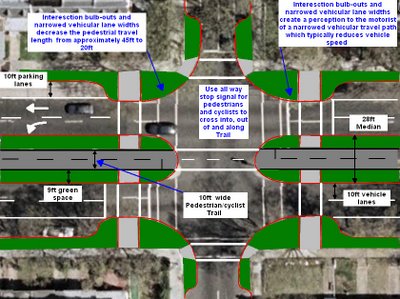Positive resident activism: C Street, NE

The high-speed portion of C Street, NE. Image by Ken Granata.
Like Dupont’s 15th Street and many others around DC, C Street, NE in the Rosedale section of Capitol Hill is a neighborhood street that traffic engineers turned into a high-speed traffic raceway. After crossing the Anacostia on East Capitol Street, the freeway-like road passing RFK Stadium dumps traffic onto C Street. According to the 2005 Capitol Hill transportation study, drivers regularly speed on this portion, making it unsafe for pedestrians and bicyclists.
Instead of waiting for a streetscape project from DDOT, residents are proactively designing a better C Street. Resident Ken Granata created a blog for the street that explores potential redesigns. Granata, who also maintains the Rosedale Citizens’ Alliance neighborhood site, advocates removing one lane between 16th and 22nd Streets. On this stretch, C is a divided highway of three lanes in each direction. Heading west on C, the road divides at 16th, with C continuing west as a narrower road and North Carolina Avenue heading southwest to Lincoln Park. This creates a bottleneck around 16th.
Instead, Granata argues, a narrow C Street will move the bottleneck to the ramps around RFK, out of the residential areas. Instead, the C Street site shows potential designs (16th Street, 17th Street, 17th Place, 18th Street, 18th Place). The proposals include bulb-outs at the corners and a widened median containing a two-way bicycle path in the center:
Residents arranged for a walkthrough of C Street with DDOT Ward 6 Transportation Planner Allan Fye on January 5th. Fye suggested also considering a physically separated bike lane on one side of the street, similar to those NYC recently added on Eighth and Ninth Avenues or one proposal for 15th Street.
Such a lane would allow cyclists to enter and exit without crossing half of C Street. On the other hand, there may not be enough space on C Street for one of these on each side including the landscaped buffers between parked cars and the bicycle lanes, whereas a two-way path in the median occupies less space. It also adds pedestrian refuges for people to stop in if they can’t cross the entire street on one light cycle. Area resident Lance Brown also suggested widening the sidewalks, writing that “Many streets, including the north side of C Street [in this area], have sidewalks that are much too narrow.”
Often, some residents reflexively oppose bulb-outs or medians because of ingrained habits through years of designing streets for cars above all else. It’s good to see residents of the Rosedale part of Capitol Hill thinking about creative solutions to reorient their streets for the benefit of all users.

